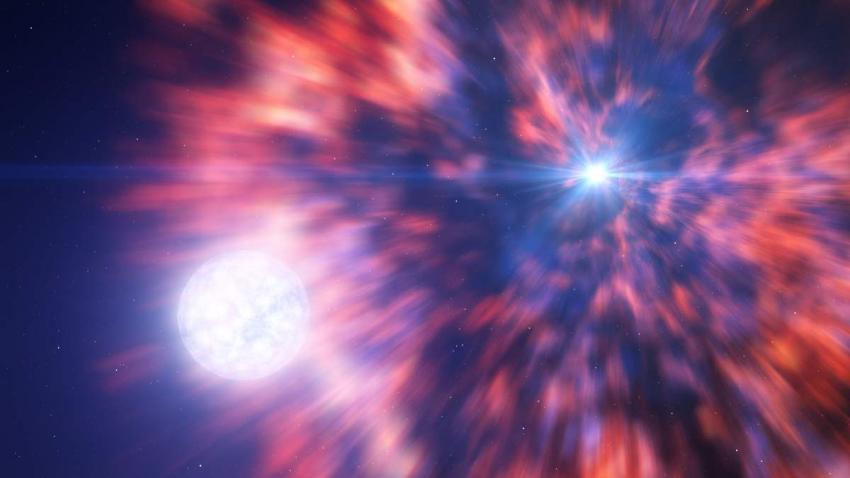Astronomers have discovered a direct link between the explosive death of massive stars and the formation of the most mysterious and compact objects in the universe: black holes and neutron stars. With the help of the Very Large Telescope (VLT) and the New Technology Telescope (NTT), both from the European Southern Observatory (ESO), two teams of researchers were able to observe the result of a supernova explosion in a nearby galaxy, thus finding evidence of a mysterious compact object left behind. .
When they reach the end of their lives, massive stars collapse under their own gravity so quickly that the result is a violent explosion known as a supernova. Astronomers believe that after all the excitement caused by the explosion, what is left is a very dense core, or compact remnant, of the star. Depending on the mass of the exploded star, the merged remnant could either be a neutron star, an object so dense that a teaspoon of its matter would weigh about a billion kilograms on Earth; Or a black hole, which is an object from which nothing can escape, not even light.
Astronomers have found many clues in the past that point to this chain of events, such as the discovery of a neutron star within the Crab Nebula, the gas cloud that resulted from the explosion of a star that occurred nearly a thousand years ago. However, this process has never been observed in real time, meaning direct evidence that a supernova leaves behind compact remnants has remained elusive. “Thanks to our work, we were able to establish a direct connection,said Ping Chen, a researcher at the Weizmann Institute of Science in Israel, and lead author of a study published today in the journal nature It was presented at the 243rd meeting of the American Astronomical Society in New Orleans, USA.
Researchers' luck changed when, in May 2022, South African amateur astronomer Berto Monard discovered the supernova SN 2022jli in the spiral arm of the nearby galaxy NGC 157, located about 75 million light-years away from us. Two separate teams studied the effects of the explosion, and discovered that it exhibited strange behavior.
After the explosion, the brightness of most supernovae fades over time; Astronomers observed a smooth and gradual decrease in the “light curve” of the explosion. However, the behavior of SN 2022jli was quite strange: although the overall brightness faded, this did not happen smoothly, but rather showed up and down oscillations, approximately every 12 days. ““We observed a recurring sequence of light brightening and fading in the SN 2022jli data.” explains Thomas Moore, a doctoral student at Queen's University Belfast in Northern Ireland, who led the supernova study published at the end of last year in the specialized journal Astrophysical Journal. “This is the first time that periodic oscillations have been detected that repeat over many cycles in the light curve of a supernova.Moore says in his scientific article.
Moore and Chen's teams believe that the presence of more than one star in the SN 2022jli system could explain this behavior. In fact, it is not uncommon for massive stars to share their orbit with a companion star, in what is called a binary system, and the star that gave rise to SN 2022jli is no exception. However, what is notable about this system is that the companion star appears to have survived the violent death of its partner, and the two objects, the combined remnant and the companion star, likely continued to orbit each other.
The data collected by Moore's team, which included observations made using… NTT From ESO, in the Chilean Atacama Desert, we were not allowed to discover exactly how the interaction between the two objects caused the ups and downs of the light curve. But Chen's team made additional observations and discovered the same regular fluctuations that Moore's team discovered in the system's visible brightness, but they also detected periodic movements of hydrogen gas and gamma-ray bursts in the system. Their observations were made using a range of instruments on Earth and in space, including… X shooter mounted on VLT At ESO, in Chile.
Taking all the information together, the two teams generally agree that when the companion star interacted with material released during the supernova explosion, its hydrogen-rich atmosphere became more puffy than usual. Then, when the compact body left by the explosion, while describing its orbit, passes through the accompanying atmosphere, it strips away the gaseous hydrogen and forms around it a hot disk of matter. This periodic “stealing” of matter, or accretion, produces enormous energy seen in observations as regular changes in brightness.
Although the teams were not able to observe light coming from the compact object itself, they concluded that this energy theft could only be due to an invisible neutron star, or perhaps a black hole, which is removing matter from the companion star's extra atmosphere. “Our work involves solving the mystery by collecting all possible clues,Chen says. “We've put together all the pieces that lead us to the truth.“
With the existence of a black hole or neutron star confirmed, there is still a lot to discover about this mysterious system, including the exact nature of the compact object or the end that this binary system could have. Next generation telescopes such as Very large telescope ESO (ELT), scheduled to become operational later this decade, will help us solve these questions, allowing astronomers to reveal never-before-seen details about this unique system.
European Southern Observatory

“Coffee trailblazer. Social media ninja. Unapologetic web guru. Friendly music fan. Alcohol fanatic.”

